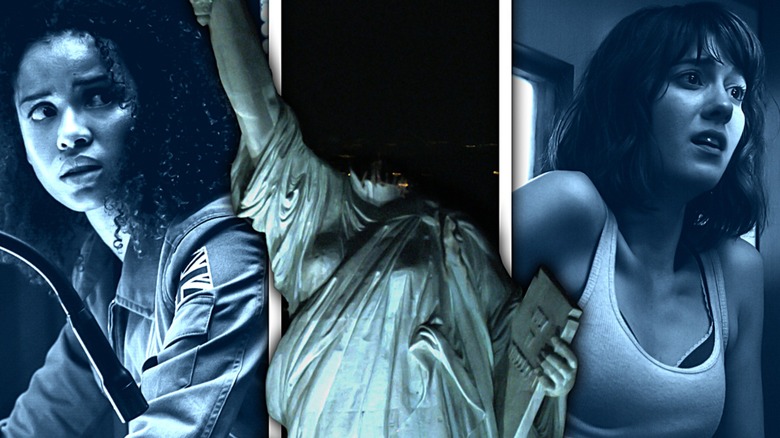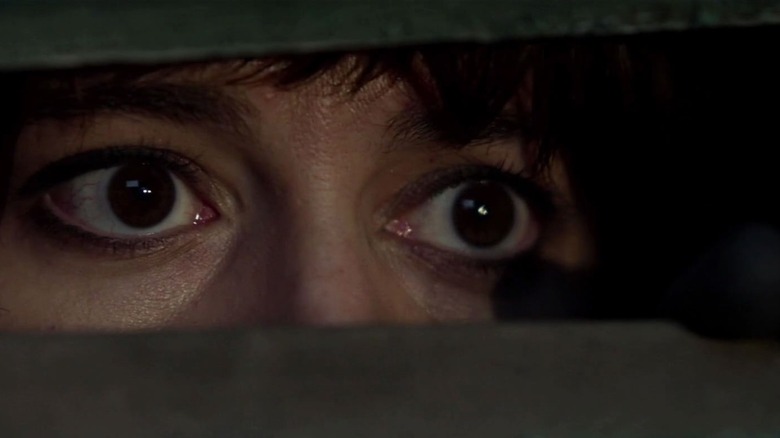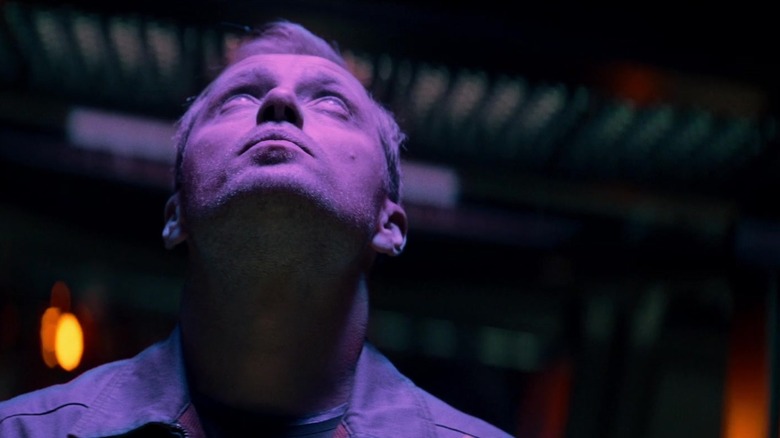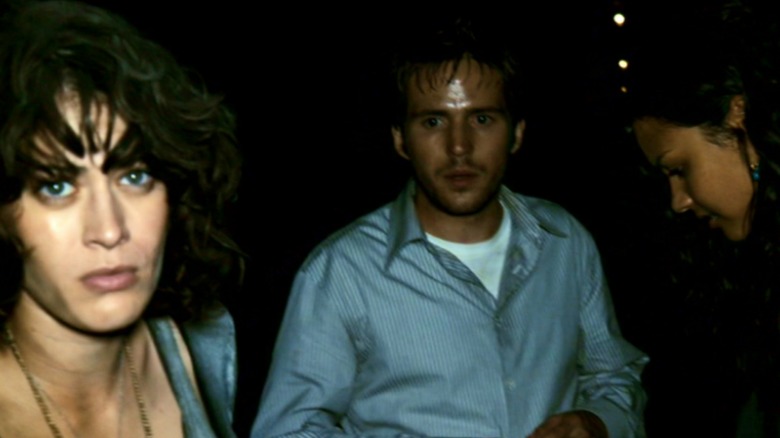The Correct Order To Watch The Cloverfield Movies
Few movies have such broad "you had to be there" appeal as "Cloverfield." Released in 2008 after a much-hyped marketing campaign featuring title-free promos and cryptic web pages, the movie wowed (and to some extent divided) audiences with a prime bit of misdirection: it was a good old-fashioned kaiju film disguised as a found footage thriller disguised as a shaky cam home video-style story.
"Cloverfield" was made during a time when J.J. Abrams was known as the mystery-crafting maestro behind "Lost," not a polarizing part of the "Star Wars" universe. Director Matt Reeves, who would go on to make the emo-Robert-Pattinson-led blockbuster "The Batman," was then known for the college-set soap "Felicity." And while the film's cast members, including Lizzy Caplan and T.J. Miller, are recognizable today, they were mostly unknown at the time of its release, lending the project a "Blair Witch"-style verisimilitude.
To understand the gloriously geeky context into which "Cloverfield" was born makes it more fun, but the franchise has its merits even without having "been there" when it all went down. Both follow-up films cultivated buzz in intriguing ways, and while only one has the payoff to back it up, all three are worth watching. But in what order should you watch them? Well, it depends on what you'd like to get out of the experience.
Release order
When it comes to movies like the "Cloverfield" franchise, in which the hype and confusion surrounding their release is as historic as the film itself, it can be extremely worthwhile to watch them in release order. If you choose this method, start with 2008's "Cloverfield," the secretive invasion horror flick that was ushered into the world after being guarded by code names and enthusiastically investigated by internet sleuths.
Next up in production order is "10 Cloverfield Lane," arguably the most enduring entry in the series. Starring Mary Elizabeth Winstead and John Goodman, this one's a paranoid kidnapping thriller that takes place largely in an underground bunker, and it ties back into the original film in clever ways. Released a full 8 years after "Cloverfield," "10 Cloverfield Lane" isn't so much a sequel or prequel as it is a genre-switching companion piece.
The franchise switched genres yet again for "The Cloverfield Paradox," a space-set 2018 film whose release was even more secretive than the original. The movie, which is somehow both only tangentially related to "Cloverfield" and attempts to explain its entire mythology, wasn't well-received by critics, but it was a major moment in the zeitgeist thanks to its incredible release strategy. "The Cloverfield Paradox" was announced in a trailer played during the Super Bowl in 2018, and dropped on Netflix just hours later — right after the game. The surprise film drew plenty of attention, but it's widely considered the weakest of the franchise.
Reverse release order, AKA by quality
While watching the "Cloverfield" films in release order with context offers an entertaining look at the evolving nature of the movie business over the course of a decade, "The Cloverfield Paradox" isn't a strong note to end on. The "Alien" meets the "Star Trek" mirror universe storyline isn't as bad as you've heard, but the movie feels forgettable compared to its predecessors, and the "Cloverfield" tie-in is somewhat tacked on (Oren Uziel's script was originally unrelated to the franchise). If you don't care about nifty marketing or genre history and simply want to enjoy these movies for what they are, your best bet is to watch them in reverse order, aka from worst to best.
If you choose this viewing experience, start with "The Cloverfield Paradox," which provides some (admittedly unconvincing) context for why there's a giant monster in the other films. Next, move to "10 Cloverfield Lane," a tense thriller that's satisfying on its own merits, and also serves to enrich the shared universe. Finally, end with the movie that started it all, "Cloverfield." This is the only film of the three that spends extensive time showing the actual impact of the Cloverfield attack the others allude to. It's a pulse-pounding apocalyptic thriller. Plus, if the franchise ever gets another installment, Reeves has hinted that it'll tie in more directly to this storyline, so you'll be primed for what's next after ending with the original.
Unlike most franchises, there's no real reason to attempt to watch the "Cloverfield" movies in chronological order, as they all feature roughly the same moment from different locations and points of view. The bulk of "The Cloverfield Paradox" takes place years ahead of the other two films, but all three include what's basically the same global monster invasion — albeit across different dimensions.
With viral marketing add-ons
For an even more complete "Cloverfield" experience, it's worth digging into the extensive multimedia elements surrounding the release of the original. When "Cloverfield" was about to drop in 2008, a number of internet tie-ins offered up coded details related to the film's plot. Among them are now mostly-defunct character Myspace pages, but you can still read through the detailed clues pieced together by sites like Cloverfield Clues and revisit the surprisingly extensive lore in retrospectives like this one by Little White Lies. Collect every clue from the viral marketing campaign, and you'll get a completely unique "Cloverfield" tale, a monstrous origin story centered around a Japanese oil drilling company.
Additionally, Shōnen Ace published a four-part manga series leading up to the release of "Cloverfield," and this, too, focused on entirely original characters. Written by David Baronoff, Matthew Pitts, and Nicole Phillips, this project ties the Tagruato drilling company Easter eggs to a plot concerning two teens in Tokyo experiencing their own monster attack — all while coming too close for comfort to a potentially dangerous cult. Of course, none of these add-ons are required for a great viewing experience, but given that the first "Cloverfield" film was perhaps the most interactive theatrical release of its decade, your viewing experience can be significantly deepened by retroactively getting in on the fun.



